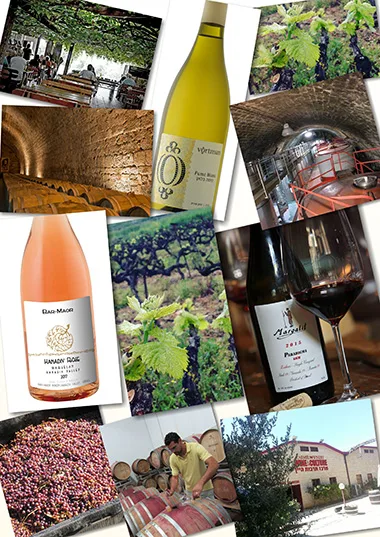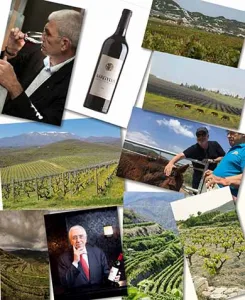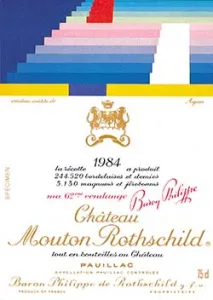There are no end of options for the wine tourist in Israel and there are wine routes that cover the country. There is the Galilee & Golan Heights in the north, Mount Carmel & the Sharon Plain in the northern coastal plain, the Judean Foothills & Judean Hills in the center of the country. To these you can now add the Central Mountains and Negev, where there also viable wine routes.
I believe Israel is a country which may be viewed through the prism of its wineries, vineyards and wines. This will put you in touch with history, archaeology, agriculture, religion, gastronomy, peoplehood and technology. Those who know Israel well, will only gain further insights by experiencing Israel’s wine industry.
Sukkot is the wine harvest festival. In ancient times it was customary for young girls to dress in their finest and to dance in the vineyards to celebrate the harvest, in the hope of catching the attention of eligible, young men. Today ‘Chol Hamoed’ of Sukkot, is an opportunity for visiting wineries, picnicking in vineyards and tasting wines in the places they are made.
Arguably the most accessible wine region, with the best concentration of wineries, is the Mount Carmel region. Even the name itself reeks of wine. The root of the word ‘Carmel’ is Kerem – El, which means God’s Vineyard. The area had a well-documented Biblical history. The beginnings of wine there, in modern times, dated back to the First Aliyah.
The first experimental vineyards sponsored by Baron Edmond de Rothschild from 1882 onwards, were planted in Rishon Le Zion and Zichron Ya’acov. They relied on some hardy Spanish varieties and then Mediterranean grape varieties from France. Rothschild’s agronomists thought the climate in Israel had similarities to the South of France.
When Rothschild first visited in 1887, he fell in love with the Mount Carmel area. He saw the mountain range, forests, sea and vineyards and decided on the spot to found an Israeli wine industry. More vineyards were planted. Carignan and Alicante were the main varieties, though he also insisted on Cabernet Sauvignon and Cabernet Franc. Then he built the two largest wineries in Israel: Rishon Le Zion and Zichron Ya’acov Cellars.
In Rishon, the new Israelis eventually learnt to value real estate more than farming, and the vineyards eventually gave away to housing. The Mount Carmel region became the largest wine growing region in Israel. With the onset of the New World wine revolution in Israel, the center of wine growing moved to the north and eastwards in search of higher altitude. The Golan Heights, Upper Galilee and Judean Hills became the new focus of quality winemaking in Israel, but the Mount Carmel region remained as the most traditional, established of the wine regions.
I use the description Mount Carmel but the official name of this wine region is the ‘Shomron’ Region. I suppose it would be too much to ask for a country without final borders to have wine appellations that make sense. However, we are really referring to the southern Mt. Carmel, not the area nearer Haifa. There are three vineyard areas: Zichron Ya’acov, arguably the main wine town of Israel, Shefaya, which is north east of Zichron and Bika’at Hanadiv. Zichron and Shefaya are in the foothills of Mount Carmel, which lead firstly into the Menashe Hills and then on into the Central Mountain range that runs down the spine of Israel. The vineyards tend to be in small valleys, each with their own micro-climate. Bika’at Hanadiv or Hanadiv Valley is the area south of Zichron and east of Binyamina. Here the vineyards tend to be larger covering a broader expanse. This is may also be described as the northern coastal plain. The word ‘Hanadiv’ (the benefactor) was the code word or nickname for Baron Edmond de Rothschild, whose memory permeates every facet of the region’s wine story.
Over the years the region has retreated somewhat. Fewer wineries have been prepared to put Mount Carmel or Zichron Ya’acov on the labels. Good examples are Carmel and Tishbi, wineries with the deepest roots in the region, but their focus moved elsewhere. Carmel began to take better fruit from the Upper Galilee and Tishbi from Gush Etzion. The region’s wines became known for being part of inexpensive blends rather than individual expressions. However, in the last ten years, the region has had a revival. The famous Margalit Winery, one of Israel’s finest, planted a new vineyard near Zichron Ya’acov, and now produces three wines with Zichron proudly written on the label as the appellation. Bar-Maor and Somek wineries started giving focus on the Hanadiv Valley region.
For the wine tourist, it remains a most fascinating region. There are many wineries, but the following are top of my list:
VORTMAN WINERY www.vortmanwinery.com The immaculate small winery is in Haifa and the visitors center and tasting room is in the family house with a beautiful vantage point high up in the Shambour district of Haifa, perched high on Mount Carmel. It overlooks terraced vineyards, trees and natural shrubs that plunge to the Mediterranean Sea. It is worth visiting only to see the view. Their main vineyards are in Zichron Yaacov and Shefaya. Owner -winemaker – grower Hai Vortman is passionate and meticulous. The winery is a rising star, one to watch. The whites, particularly the Sauvignon Blanc, are outstanding and the reds are not far behind. I particularly like the Carignan Grenache blend.
AMPHORAE WINERY www.amphoraewines.com This is the most beautiful winery in the region, and no doubt one of the most beautiful wineries in Israel. It is situated in an attractive stone building in the heart of the Makura farm, adjacent to Kerem Maharal in the foothills of Mount Carmel. They are surrounded by fig and persimmon orchards along with olive groves. They specialize in organic produce. To get to the winery, you have to pass the Makura Olive Press. How appropriate! Though vineyards and olive trees are partners, crisscrossing the country, it is rare to find a winery and olive press as neighbors. The winery has state-of-the art equipment, an internationally famous Israeli winemaker resident in California and an active visitors center. Well worth a visit.
CARMEL WINERY – ZICHRON YAACOV CELLARS (K) www.carmelwines.co.il Carmel is the historic winery of Israel. The Zichron facility, built in 1892, is the oldest winery still in use and to my knowledge it is also the oldest factory still in use in the country. For over 125 years Carmel was the largest winery in Israel. The first time the telephone and electricity were used in Israel was at the winery and no less than three prime ministers of Israel worked there. During most of this time the main winery was Rishon Le Zion Cellars, but when they stopped receiving grapes after 2010, Zichron became Carmel’s main winery for the first time. It worth seeing the deep underground cellars built by Rothschild and the old accounts books where baksheesh (a tip or bribe) is listed as one of the expenses.
SMADAR WINERY www.smadar-inn.com For accommodation the formal traveler may choose between Carmel Forest Hotel to the north of the wine country or Dan Caesarea Hotel to the south. However, if you are looking for a more authentic, rustic experience, the Shapira family of growers have a boutique hotel known as the Smadar Inn and a winery in the heart of Zichron Ya’acov. The family have been wine growers for well over 130 years. They came from Romania to plant the vineyards for Rothschild. They live in one of the founder’s houses in Hameyasdim Street. Their old vine vineyard is in Shefaya.
SOMEK WINERY www.somek-winery.com Barak Dahan is a fifth generation vineyard owner, whose family have been grape growers since 1882. His wife Hila, studied winemaking in Australia. They live in the center of Zichron Ya’acov and founded Somek Winery in 2002. The family vineyards are in Hanadiv Valley. They make an excellent Carignan, the variety most associated with the region, and a good Chardonnay. It is one of the better boutique wineries in the country.
TISHBI WINERY (K) www.tishbi.com The Tishbi family are a family of vineyard owners who planted vineyards in Shefaya. In 1985 Yonatan Tishbi founded Tishbi Winery. His was the pioneer small winery in Israel. Now his son Golan has converted the winery into a center of food, wine and chocolate. There is a dairy restaurant underneath a pergola of vines, a great place for lunch or breakfast, and a popular smoked meat barbecue on Fridays. That is not all. There is a bakery, fruit preserves, wine jams, olive oil and family made ceramics. Winos and chocoholics should not miss the wine and chocolate tastings and it is also worth seeing the authentic cognac still, used for making brandy. Alternatively, you can visit the promenade in the center of Zichron Ya’acov. This will give you a feeling of pre state Israel. There you can visit the Tishbi Coffee Shop Restaurant
BINYAMINA WINERY (K) www.binyaminawines.com Binyamina Winery is a large, old winery, founded in 1954. It was originally named Eliaz. The visitors center is in a building built by the Rothschilds in 1925 as a jasmine factory. The factory closed, but Binyamina Winery is still standing. The winery wines range from the expensive boutique prestige ‘The Cave’ to some varietals to match every price point. This is a good place to buy inexpensive wines representing good value for money.
MARGALIT WINERY www.margalit-winery.com One of Israel’s finest wineries founded by Yair Margalit, one of the founding fathers of quality wine in Israel. Margalit Winery was Israel’s first quality boutique winery and Israel’s first cult wine. The winemaker today is Yair’s son Assaf Margalit, one of the best young winemakers in the country. Their Cabernet Franc, arguably the best in Israel, comes from a vineyard in Binyamina and their more recent Paradigma GSM (Grenache, Syrah, Mourvedre), Optima (mainly Chardonnay blended with a local, unique mutation that they call Margalit Blanc) and Riesling all come from the northern part of the Hanadiv Valley, south of Zichron Ya’acov. There is no visitors center here and any visit has to be especially organized. A visit is expensive, but certain costs will be offset if you are a wine buyer!
BAR-MAOR WINERY www.barmaor.com Margalit Winery is adjacent to Binyamina Station and five minutes away is Bar-Maor Winery. It one of Israel’s most interesting and individual boutique wineries, certainly one espousing the most natural wines. Owner winemaker Rami Bar-Maor is a pioneer of the Hanadiv Valley as a quality wine growing region. He makes wine with minimal intervention. There is no artificial irrigation in the vineyard and no pressing, filtration or cold stabilization at the winery. I love his fresh, crisp rose, his summer red Tammuz and his rare Merlot called Red Moon. Best is hearing him explain his world view, whilst enjoying the fruits of his art.
Other options for a visit, include Tulip, Salomon, Alona, Eyal, Bat Shlomo wineries and even the Meir Shefaya School Winery. Any could be added to a tour. However, with any winery, it is worth booking in advance. Those with visitors’ centers may become busy but the smaller wineries may depend on one or two people being available at the time you want to visit.
Finally, I recommend a pilgrimage to RAMAT HANADIV. Situated between Zichron and Binyamina, it overlooks the sea on one side and the vineyards the Baron loved so much on the other. This is a living memorial to Baron Edmond de Rothschild. It worthwhile seeing the beautiful gardens, nature park and ancient wine press. The Mataim Restaurant is a dairy restaurant for the hungry. Last but not least, it is worth visiting the Memorial Gardens, in the heart of Ramat Hanadiv, where Baron Edmond and his wife, Adelaide, were laid to rest. Pay respect to the founder of a modern Israeli wine industry and enjoy the calmness and tranquility of the surrounding gardens.
Adam Montefiore has advanced Israeli wines for over thirty years and is the wine writer for the Jerusalem Post. www.adammontefiore.com

















